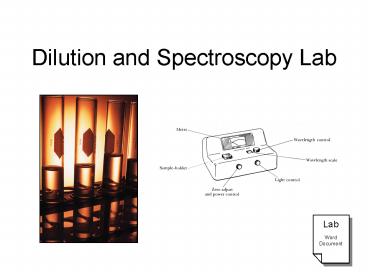Dilution and Spectroscopy Lab PowerPoint PPT Presentation
1 / 13
Title: Dilution and Spectroscopy Lab
1
Dilution and Spectroscopy Lab
Lab Word Document
2
Dilution Background
- Acids and bases usually come in concentrated
form, as concentrates, but they are rarely used
in this form. - A dilution is prepared by adding a specific
amount of a concentrate to water to obtain a new
volume and concentration. - In order to calculate dilutions of solutions the
equation - M1V1 M2V2
- where M is concentration in molarity (mol
solute/L solution) and V is volume (L), is used
3
Dilution Examples
- Dilutions by a factor of 2
- Take 3 mL of acid and dilute with 3 mL of water
- 1 part concentrate, 1 part water
- Dilutions by a factor of 4
- 1 part concentrate, 3 parts water
- Dilutions by a factor of 10
- 1 part concentrate, 9 parts water
4
Pipet Instructions
A
E
S
- Press the A button and squeeze the bulb to
suck air out - Place the pipet into the solution
- Press the S button to suck the liquid into the
pipet - Take the pipet out of the solution and place it
into the next cuvette - Press the E button to empty the liquid into the
new cuvette
5
Spectroscopy Introduction
- Spectroscopy is one method of determining the
concentration of an unknown solution. - By measuring the respective absorbance values for
solutions with known concentrations, a
calibration curve can be constructed. - The absorbance of an unknown can be used to
determine its concentration through use of this
calibration curve.
6
Absorbance vs. Transmittance
- Transmittance - the fraction of light that is
transmitted through a sample - Absorbance - The fraction of light that is
absorbed by a sample
100 Transmittance
0 Absorbance
7
Spec-20 Instrument
Wavelength control knob
Light control knob
Amplifier control knob
Sample holder cover
8
Schematic representation of a spectrophotometer
I
Io
Detector
Monochromator
Meter
Light Source (1)
Sample cell (3)
(2)
(4)
(5)
A spectrophotometer is an instrument that
measures the fraction of an incident beam of
light which is transmitted or absorbed by a
sample at a particular wavelength.
9
Spec-20 Absorbance
Insert Photograph Spec-20
100 Absorbance 0 Transmittance
Absorbance
0 Absorbance 100 Transmittance
l (wavelength)
10
Absorbance of Chlorophyll
1.5
1.2
0.9
Absorbance
0.6
0.3
0.0
300
400
500
600
700
800
Wavelength (nm)
11
Amount absorbed
663 nm
400
500
600
700
Wavelength (nm)
Kelter, Carr, Scott, , Chemistry A World of
Choices 1999, page 480
12
Calibration Curve
(fixed wavelength)
100 Absorbance 0 Transmittance
out of linear range (too concentrated)
?
Absorbance
0 Absorbance 100 Transmittance
x 2
Concentration
Dilute sample with water 5050. Run sample, read
concentration.
13
Dilution of Solutions
Dilution of Solutions Dilution of Solutions
Dilution of Solutions Dilution of Solutions
Keys
http//www.unit5.org/chemistry/Solutions.html

